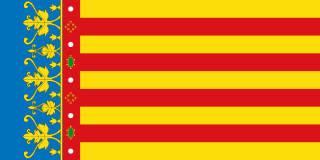
Valencian or the Valencian language is the official, historical and traditional name used in the Valencian Community of Spain to refer to the Romance language also known as Catalan, either as a whole or in its Valencia-specific linguistic forms. The Valencian Community's 1982 Statute of Autonomy officially recognises Valencian as the name of the regional language.

The Catalan Countries are those territories where the Catalan language is spoken. They include the Spanish regions of Catalonia, the Balearic Islands, Valencian Community, and parts of Aragon and Murcia (Carche), as well as the Principality of Andorra, the department of Pyrénées-Orientales in France, and the city of Alghero in Sardinia (Italy). It is often used as a sociolinguistic term to describe the cultural-linguistic area where Catalan is spoken. In the context of Catalan nationalism, the term is sometimes used in a more restricted way to refer to just Catalonia, Valencia and the Balearic Islands. The Catalan Countries do not correspond to any present or past political or administrative unit, though most of the area belonged to the Crown of Aragon in the Middle Ages. Parts of Valencia (Spanish) and Catalonia (Occitan) are not Catalan-speaking.

Las Hurdes is a comarca in the Sistema Central, at the northern end of the province of Cáceres in the Autonomous Community of Extremadura, Spain. A well-known historical region, Las Hurdes is currently a Site of Community Importance of the European Union.

Arroz a la valenciana or Valencian rice is a name for a multitude of rice dishes from diverse cuisines of the world, which originate from the rice-cooking tradition of the Valencian Community, in eastern Spain.
The names of the Valencian Community are diverse, even though Comunitat Valenciana is the only denomination with official status in its Statute of Autonomy. Nonetheless, this legal document includes in its Preamble other legal denominations that portray the history and nature of the territory: Regne de València and País Valencià.
Blaverism is a Valencian regionalist ideology in the Valencian Community (Spain) that emerged with the Spanish transition to democracy characterised by strong anti-Catalanism, born out of its opposition to Joan Fuster's book Nosaltres, els valencians (1962), which promoted the concept of the Catalan Countries which includes Valencia. They consider Fuster's ideas as an imperialist Catalan nationalist movement that tries to impose Catalan domination upon Valencia. Blaverism takes its name from the blue fringe which distinguishes the Valencian flag from other flags with a common origin, particularly from the Catalan.

Valencian Left was a nationalist Valencian leftist political party founded in July 1934, that advocated self-determination of the Valencian Community. The party was suppressed in Francoist Spain and was not revived when democracy returned to Spain in the late 1970s.
Valencian nationalism or Valencianism is a political movement in the Valencian Community, Spain.

The Valencian Community is an autonomous community of Spain. It is the fourth most populous Spanish autonomous community after Andalusia, Catalonia and the Community of Madrid with more than five million inhabitants. Its homonymous capital Valencia is the third largest city and metropolitan area in Spain. It is located along the Mediterranean coast on the east side of the Iberian Peninsula. It borders Catalonia to the north, Aragon and Castilla–La Mancha to the west, and Murcia to the south, and the Balearic Islands are to its east. The Valencian Community is divided into three provinces: Castellón, Valencia and Alicante.

Aljezur is a town and municipality of the District of Faro and Algarve region, in Portugal. The population in 2011 was 5,884, in an area of 323.50 km2. The municipality comprises 4 parishes.

Valencians are the native people of the Valencian Community, in eastern Spain. Legally, Valencians are the Spanish inhabitants of the community. Since 2006, the Valencian people are officially recognised in the Valencian Statute of Autonomy as a nationality "within the unity of the Spanish nation". The official languages of Valencia are Valencian and Spanish.

Ricardo J. Vicent Museros was a Spanish printer and publisher. After studying in Germany he returned to Valencia with new methods of work, advertising and graphic marketing. He founded the "Museo Nacional de la Imprenta y la Obra Gráfica" in El Puig de Santa María. He promoted the twinning of the cities of Valencia and Mainz (Germany). In 1992, the International Gutenberg Society granted him the "Gutenberg Prize" and in 2003 he received the "Cross of Civil Merit" from the German government for his work in favour of cultural relations between Spain and Germany.
Valencian regionalism is a cultural and political movement that advocates the revival of the identity of the region now within the Valencian Community in eastern Spain. Politically, the regionalists support the administrative decentralisation of the Spanish state and, for some, the recognition of Valencian foral law and increased autonomy for the Valencian Community. The movement emerged during the early years of the Bourbon restoration in the last third of the 19th century. It took political shape during the early 20th century, and persisted in a controlled and attenuated form through the Francoist State. After the restoration of democracy, the regionalist tendency was challenged by a Valencian nationalism with some left-wing and pan-Catalanist associations. Regionalism took on a right-wing and anti-Catalanist outlook which became known as Blaverism, and was represented politically by the Valencian Union until the absorption of that party into the People's Party in 2011.
Maria Beneyto Cuñat was a Spanish poet. She was a recipient of the Premio de las Letras Valencianas.

Valencian Art Nouveau is the historiographic denomination given to an art and literature movement associated with the Art Nouveau in the Valencian Community, in Spain.
Amparo Cabanes Pecourt is a Spanish historian, professor of paleography, writer, and politician. From 1981 to 1983 she was a Councilor of the Valencian Community. In her writings she has defended the position that Valencian is not Catalan.

The second government of Ximo Puig was formed on 17 June 2019, following the latter's election as President of the Valencian Government by the Corts Valencianes on 13 June and his swearing-in on 15 June, as a result of the Socialist Party of the Valencian Country (PSPV–PSOE) emerging as the largest parliamentary force at the 2019 regional election. It succeeded the first Puig government and was the Valencian Government from 17 June 2019 to 19 July 2023, a total of 1,493 days, or 4 years, 1 month and 2 days.

María Teresa Oller was a Spanish composer and folklorist of the Valencian Community. Since the 1950s, she carried out extensive fieldwork to collect traditional Valencian music, highlight it, and make it known in numerous publications. Oller was a member of the Real Academia de Bellas Artes de San Carlos de Valencia.

Pobles del Nord is the 17th district of the city of Valencia (Spain). It is composed of seven towns, which were annexed to Valencia between 1888 and 1900, which are today considered neighborhoods: Benifaraig, Pueblo Nuevo, Carpesa, Casas de Bárcena, Mahuella, Tauladella, Rafalell i Vistabella, Masarrochos and Borbotó.

Benifaraig is a pedania of the city of Valencia (Spain), belonging to the district of Poblados del Norte. It is bordered on the west by Godella, on the east by Alfara del Patriarca, on the north by Moncada and on the south by Borbotó and Carpesa. Its census population in 2022 was 993 inhabitants. It was an independent municipality until 1900, when it became a pedania of the city of Valencia.
















